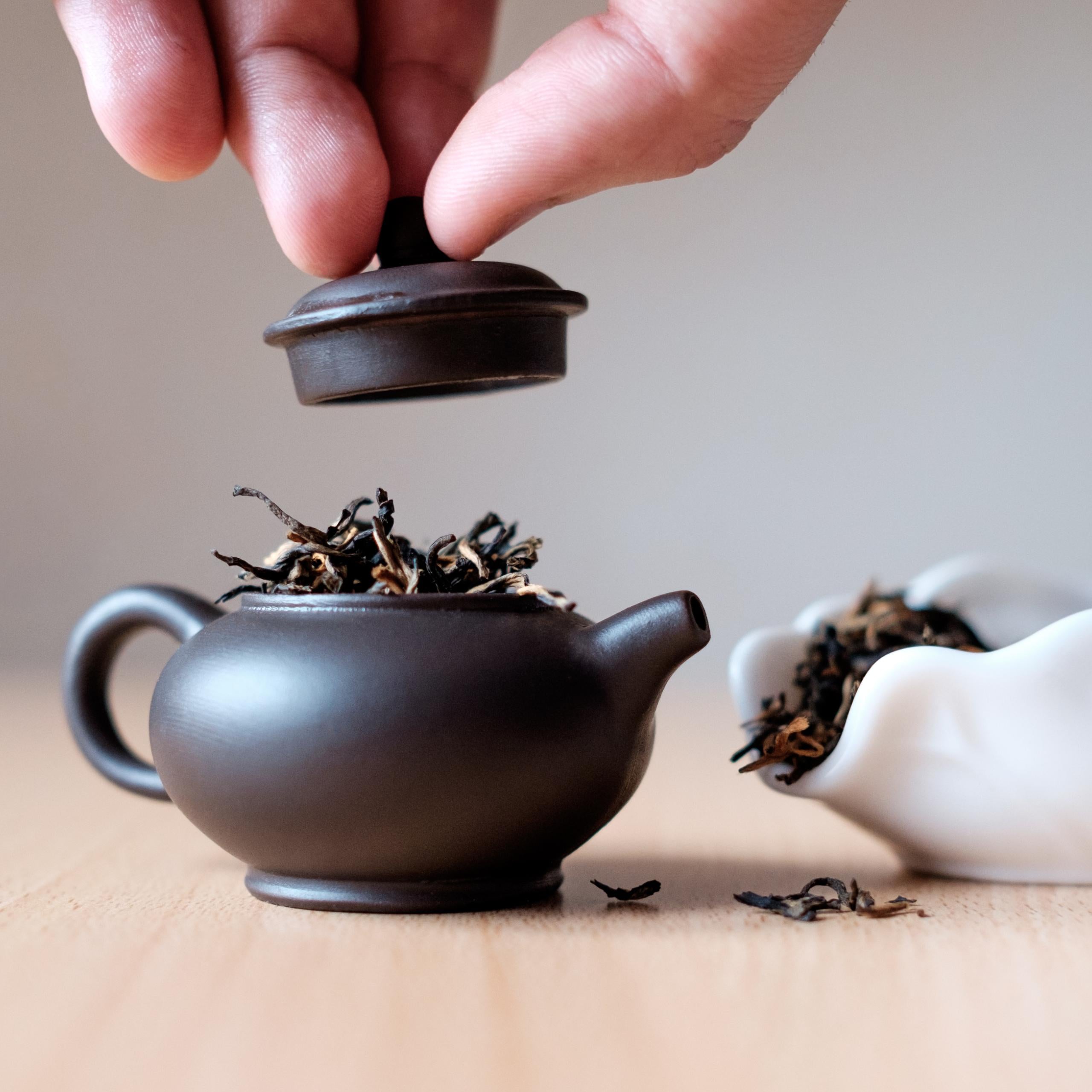
This article is part 3/3 of our gongfu tea series. Here we will give our opinion as to whether or not gongfu brewing your tea is the best way to brew. Let’s just say, in short, yes, we really think so.
In case you are still new to the concept of gongfu tea, then please take a look at part 1/3 of our series for an introduction. If you already know the basics, but want to know more about all the tools and steps in the ceremony, then please take a look at part 2/3 for a more in-depth read.
A few arguments against
We often hear people say that they find the full gongfu tea ceremony too rigorous, that there are too many steps, too many rules, and that it is too time-consuming. Or that they don’t have all the tools. Or that it’s not possible when brewing solo. Or that it’s uneconomical having to use more tea leaves. Or that it’s simply not that fun having to use scales to weigh the dry leaves and a timer to keep track of infusion times. Maybe we’ve heard a few more, but those are the main ones, more or less.
A few arguments in favour
One of the more obvious reasons for doing gongfu tea is the ceremony and its aesthetic and social aspects. However, in our opinion, the main reason in favour of gongfu tea is the brewing style, which gives the ability to extract, and give clear definition to, only a part of the full flavour spectrum with each infusion.
Simplifying the gongfu tea process
Just to be clear, it is possible, and we believe also perfectly acceptable, to brew gongfu style without performing the full ceremony. In order to do so, all we need to do is remove all the optional tools and steps in the ceremony. This means that at its most basic, when brewing solo, all we need is a kettle, brewing vessel and drinking cup. When brewing for more than one person, a fairness cup should also be used. That’s it. It can be as simple as this.
Brewing parameters
Remember, as mentioned in part 1/3, gongfu tea should use a high leaf-to-water ratio, small brewing vessel, short infusion times and have many steeps. Actually, the small brewing vessel part isn’t really that important, as long as we maintain the correct leaf-to-water ratio. A small teapot just helps us do that.
When brewing, we have three parameters that we can control which affect the strength and flavour of the brew. These parameters are water temperature, infusion time and leaf-to-water ratio, and all of these work in tandem. Let us compare gongfu style to western style, which lies at the other end of the range of brewing styles. The first of these parameters, temperature, will be the same for both gongfu and western. The last two parameters, however, is where gongfu style is different and gets its advantages.
A quick summary of the effects of the three parameters:
● Temperature affects at what rate various compounds are extracted from the tea leaf. Higher temperature speeds up the extraction rate. However, the effect of temperature is not necessarily identical, nor linear, on the various compounds. With a small increase in temperature, the extraction rate for one compound may speed up more than the extraction rate for another compound. Note that higher temperatures extract more of the polyphenols and methylxanthines, which result in higher levels of astringency and bitterness.
● Infusion time affects the strength of the brew. Longer infusion time allows more of the compounds to be extracted. Note that infusion times which are too long may have an effect of stewing the tea leaves, thereby altering the chemical structure of certain compounds. This can result in undesirable sour and cooked vegetable flavours. Shorter infusion times, as with gongfu style, avoid this.
● Leaf-to-water ratio affects the depth of flavour. Fairly obvious, but worth stating, a higher leaf-to-water ratio concentrates more compounds into less water. Note that with higher ratios, care must be taken to give the tea leaves enough space to unfurl fully in order to allow a balanced extraction.
Repeating the exact same words we used earlier – as this is absolutely key – the main argument in favour of gongfu style brewing is the ability to extract, and give clear definition to, only a part of the full flavour spectrum with each infusion.
Now, going back to our brewing parameters, we can therefore state the following. Infusion time determines into how many parts we divide the flavour spectrum. Leaf-to-water ratio determines the saturation of each of those parts. A high ratio is essential if we want to saturate each part with enough flavour compounds to give them clear definition. Each infusion will progress along the flavour spectrum, offering new flavour notes, whilst others fade out. It is only after experiencing a tea session in this manner, through gongfu style brewing, that tasting note write-ups can be fully appreciated.
In comparison, simply put, western style aims to produce an infusion with as much flavour as possible, using the least amount of tea leaves (and effort) possible. In practice this means that all the flavours are extracted into usually just one infusion. No longer can all the individual flavour notes be defined as clearly, but rather they become muddled into one big brew.
Practical tips
On average gongfu tea uses 4-6 times more leaves than western style. Some say this is uneconomical. However, we would argue that this is largely balanced out as you are doing more steeps, as well as producing a more flavoursome tea with each steep.
With regards to controlling the two main parameters, for those who do not have weight scales and a timer, here are some tips you can follow that will still allow you to brew gongfu style.
For leaf-to-water ratio, roughly fill the teapot as follows: 1/5 to 1/4 full for tightly rolled teas (i.e. pellet-shaped); 1/4 to 1/3 full for compressed teas; 1/3 to 1/2 full for loosely rolled teas. Depending on the type of tea, this will be anywhere from 3-8g per 100ml, but mostly closer to 5g per 100ml. Use proportionately less tea for larger teapots.
For infusion time, well, there are no clever tricks here. Just count internally for each steep. It’s best to start by under-brewing and add more seconds to subsequent steeps if you feel the brew is too weak. Depending on the type of tea, this will be anywhere from 15-30 seconds for the first steep, but can be as short as 5 seconds. Add 5-15 seconds for each additional steep. Remember to factor in the time it takes to pour out the contents from the teapot.
If you want to keep your gongfu tea sessions consistent or want to be able to adjust parameters in order to compare sessions, then weight scales and a timer are advisable. As would be a kettle with temperature control. However, these tools are optional, and in fact were not available when gongfu tea first originated. We know many seasoned gongfu tea brewers who still prefer to follow their senses and intuition.
Conclusion
In our opinion, gongfu tea need not be complicated. As long as you are making sure to use short infusion times and a high leaf-to-water ratio, then you are doing gongfu tea. Whether or not you wish to add ceremony to that is up to you. Feel free to experiment with infusion times and amount of leaf, after all, taste is an individual experience. Lastly, we also want to say that there is nothing wrong with western style brewing, this method certainly also has its time and place. However, if you want to take your tea sessions to the next level, we highly recommend gongfu style brewing.
-
What's next?
Feel like putting your gongfu brewing skills to the test? Then there is nothing more suitable than a classic A Li Shan. Want to treat yourself to something truly special? Then we have to recommend our Hong Yun, the rarest of Taiwanese teas with incredibly fine citrus notes.
Subscribe and get US$10!
Did you enjoy reading this article? Perhaps even learn something new? If so, we'd love it if you joined our newsletter so that we can occasionally reach out to let you know about our fresh tea harvests and new educational content. Also, we'll send you a US$10 discount coupon as a thank you for joining!

Leave a comment